 Today was the first day of the workshop in Sydney. After some adminstrative issues and handing out the t-shirts, Master Chen took control and started in quick sucession of static 3 count elbow in, turn waist, hand out. Soon this developed in stepping positive circles, and before everyone recovered the class was already twisting (wringing) the towel. We also explored the three way split, the effect of the resultant power (usually the other person on the ground).
Today was the first day of the workshop in Sydney. After some adminstrative issues and handing out the t-shirts, Master Chen took control and started in quick sucession of static 3 count elbow in, turn waist, hand out. Soon this developed in stepping positive circles, and before everyone recovered the class was already twisting (wringing) the towel. We also explored the three way split, the effect of the resultant power (usually the other person on the ground).
We then continued with an extensive series of applications related to the movements of ‘Buddha’s Warrior’, and Master Chen demonstrated various variations to the applications with the foot kicking in the knee, the foot sliding behind the leg, the foot sliding behind the leg and kick the opponents leg from under them, the split of the kua at the front for higher moves and the back kua for lower hand moves, how the three way split applies to this, and much, much more.
If today is any guide for tomorrows session from 9am to 5pm, its going to be another action filled day.

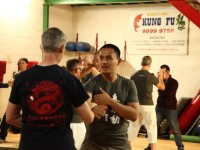
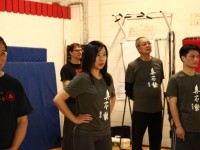
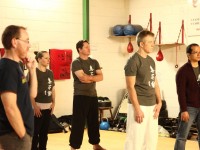
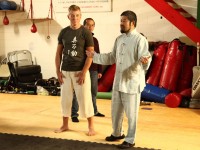
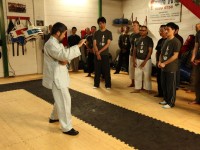
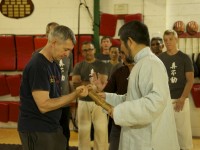
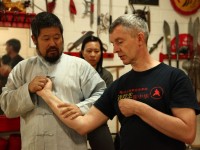
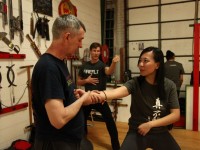
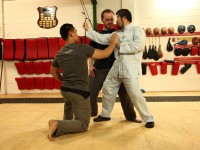
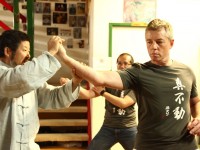
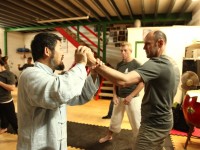
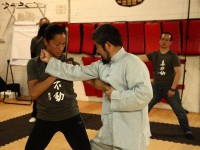
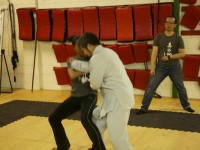

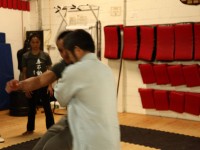
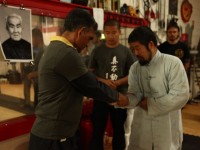
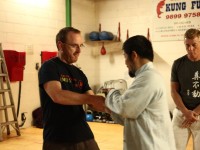
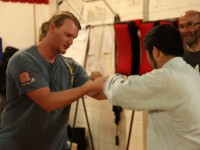

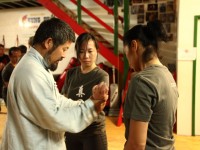
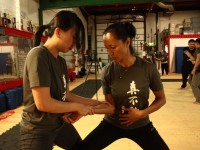

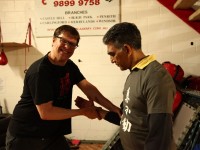
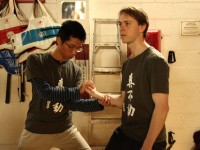
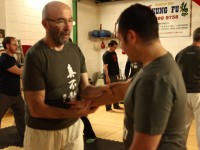
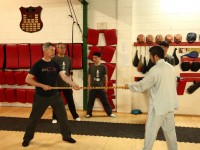
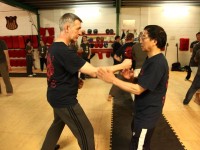
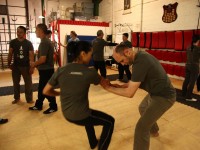
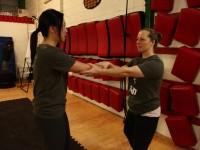
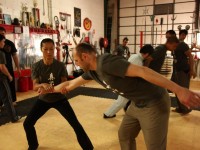
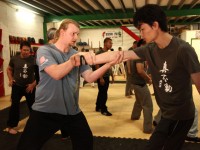
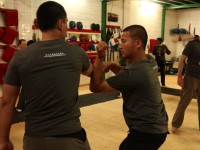
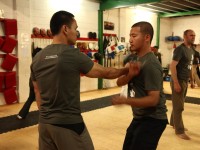
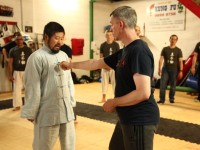

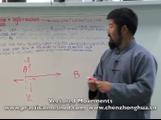
{ 4 comments… read them below or add one }
This is from the Sydney Workshop – Day 1:
CZH: ” Before we start, I’d like to reiterate that Taiji is the art of yin and yang.”
CZH: “The learning assumes that we do not know yin and yang. We have to create yin and yang on our body, in order for our body to do taiji. So right now, some things are already pre-made to do yin and yang. And other things are not. So, the exercise of foundations and the yilu, will refine the body, and redefine. re-categorize body parts so that yin yang separation and the division is made possible.”
—
[After the above talk, CZH explains yin and yang using a door and its hinge to demonstrate. After the demonstration, students get to do an exercise – not described here]
—
As introduction to exercise 2, CZH asks a student (Kevin Chen) to stand on the other side of the door in the back of the training room, and to push against the door to provide pressure. CZH is on this side of the door and pushes against the door to open it inward against the pressure that Kevin provides. The door opens slightly]
CZH: “Can you see?” [CZH’s front foot stepped into the space of the door that opened slightly, so that the door can no longer completely close]
CZH: “Did you see that? I stop it [the door from closing again]. That is about half an inch. (1.252cm)”
[CZH pushes the door again, and again steps his foot in a little further. The door now remains open slightly more]
CZH: “See? That [stepping in with the foot] again.”
CZH: “And that again…”
[And more]
CZH: “And that again…”
{Door is now further open]
CZH: “See that? That is the mechanism for doing taiji. IT IS VERY IMPORTANT THAT YOU FOLLOW THIS PROCEDURE.”
CZH: “So, this is the wrong procedure” [Opens the door by pushing, but does not put his foot in, so the door is closed again as Kevin pushes agaisnt the door from the other side. CZH tries to do this several times]
CZH: “After thirty years, there are still people trying to do that.”
[CZH asks Kevin to join the other students again]
CZH: “But, do you (Kevin) know what really happened? I put my foot there. You know, you can feel it. … That foot there, is your kua. It is called Tien Kua. Tian is ‘to fill in the blank’. So, when you push, you create space. That space is blank. And, you have to fill it. Because, if you don’t fill it, when you let go to do the next move, your opponent comes back. He’s like water. It is likewater. You push the water in … if, let’s say, you don’t move the board in [makes action as if pushing a board forward ,away from his body, and then pulls it back], and you pull it back, the water comes back. That QUALITY is very normal. It is just, if there is space, it fills it up automatically. And, the human body, human actions, based on the way our energy works, is like that.”
CZH: “If you don’t have a jam, it comes back.”
CZH: “So, our movement MUST come with a jam. That jam is a secret. And, it is on the lower part of your body. Because the foot is the jam.”
CZH: “So, you have to incrementally do that” [demo’s by placing his L heel out about 20cm without shifting his body foward. Then, closes the L foot and the body is shifted sideways in space]
CZH: “THIS MOVE IS VERY IMPORTANT.”
You can see master chen demonstrating it in DVD 3 Ireland, Filler Takes up Space, and more precisely at 2.03 Foot and the Wedge
http://practicalmethod.com/2010/05/ireland-workshop-2010-3-online-video-purchase/
Continuation of Exercise 2 – – – Chan Chu
The following part relates to the principle of “Movement must be vertical, not horizontal”
The understanding of vertical movements (line) and horizontal movements (line) is vital. Chen Style Taijiquan Practical Method system requires that all movements must be along the vertical line, not the horizontal line.
Vertical line is defined as the lengthwise line; horizontal line is defined as the width-wise line.
When this principle is followed, movements will also comply with the adage of “long overcoming short”.
CZH: “The ancient people say that in the transmission of Taiji, the teacher would rather teach 100 hand techniques, than one foot technique”
[Next CZH asks one of the students to put his hand against his L hip bone, with enough constant pressure to lock the hip in place, thus disabling CZH from moving his hip forward. He then tries to make a ‘normal’ step forward, but because his hip is restricted, falls. CZH in effect pushes himself off (fights) against the hand that prevents him from moving]
CZH: “When we are fighting, we have no power because we are doing this [normal stepping]. But this time, watch [CZH steps leg out without bringing the hip forward], can you see? I gained space.”
[Next CZH demonstrates the same principle by asking two students to prevent his knee from moving forward]
CZH: “So this is wrong [body moves forward, knee fighting against the students holding the knee]. But now, watch, I go, duck, dig, underneath it. And then land [my foot], the alignment pulls me up. And then [does ‘shovel out’ step again] can you see? I land there, and then pull me up.”
CZH: “This is called the taiji stepping. And, taiji stepping is called Chan Chu 铲出. If I would use English, I would say: ‘Shovel Out’”
[Next CZH asks a student to stand in the horse stance, and now holds a 2m stick to demonstrate the principle]
CZH: “This is normal out. [uses stick to hit the chin of the student] This is normal; we all want to do this. This time, look, [the stick now touches the student on the inside of the leg], pretend to be gentle, and go like this” [the stick slides long, still touching the leg, but sliding underneath until it touches the ground behind the student]”
CZH: “Now, you see, he thought I was touching him, but I used that touching point as a point of reference for him to fell. But I went longer [sliding the stick underneath until it touches the ground] But that dot [Fixed point], where I touched him, never moved. I now I do this” [CZH lifts stick up and student falls back]
CZH: “It is a simple method of lever, it is just like you pry something [against the anchor point of the stick on the ground, and the lifting on the stick on the other end is the indirect power]”
CZH: “YOUR FOOT MUST ALWAYS DO THIS”
CZH: “And this is why we call it Chan Chu, we say, YOU CAN’T STEP OUT. When you are making a mistake, the teacher said: You are stepping again, don’t step. And so, at the beginning I say: But what if I don’t step, what do I do? He says: CHAN CHU!!!”
CZH: “EVERY MOVE MUST BE LIKE THAT”
–
CZH: “Every move is ‘TO SHOVEL OUT’. 45 degrees, two 45 degrees.”
[Orients himself on North-South axis, and demonstrates ‘SHOVEL OUT ‘ step with L leg/foot]
CZH: “As you can see this North-South (N-S) line and this East-West (E-W) line here, I step out 45 degrees here [to the NW]. That is number 1. Number 2, I’m standing here [grabs stick and shows the vertical of R shoulder/R kua] on this [R] leg here, it [the L leg/foot] goes out [45 degrees]. So these two 45 degrees are the magic numbers. When you’ve got these two, one is horizontal, one is vertical. When you have the horizontal and vertical 45 degrees, your opponent cannot feel power. To him it feels like a wave, an energy, nothing there, just a wave of energy will push them away. If the degree is a little bit less, he will feel you are either weak, or you are too strong, AND THIS HERE IS VERY IMPORTANT!!
Is this workshop in video? I can’t find it. Maybe with other name?